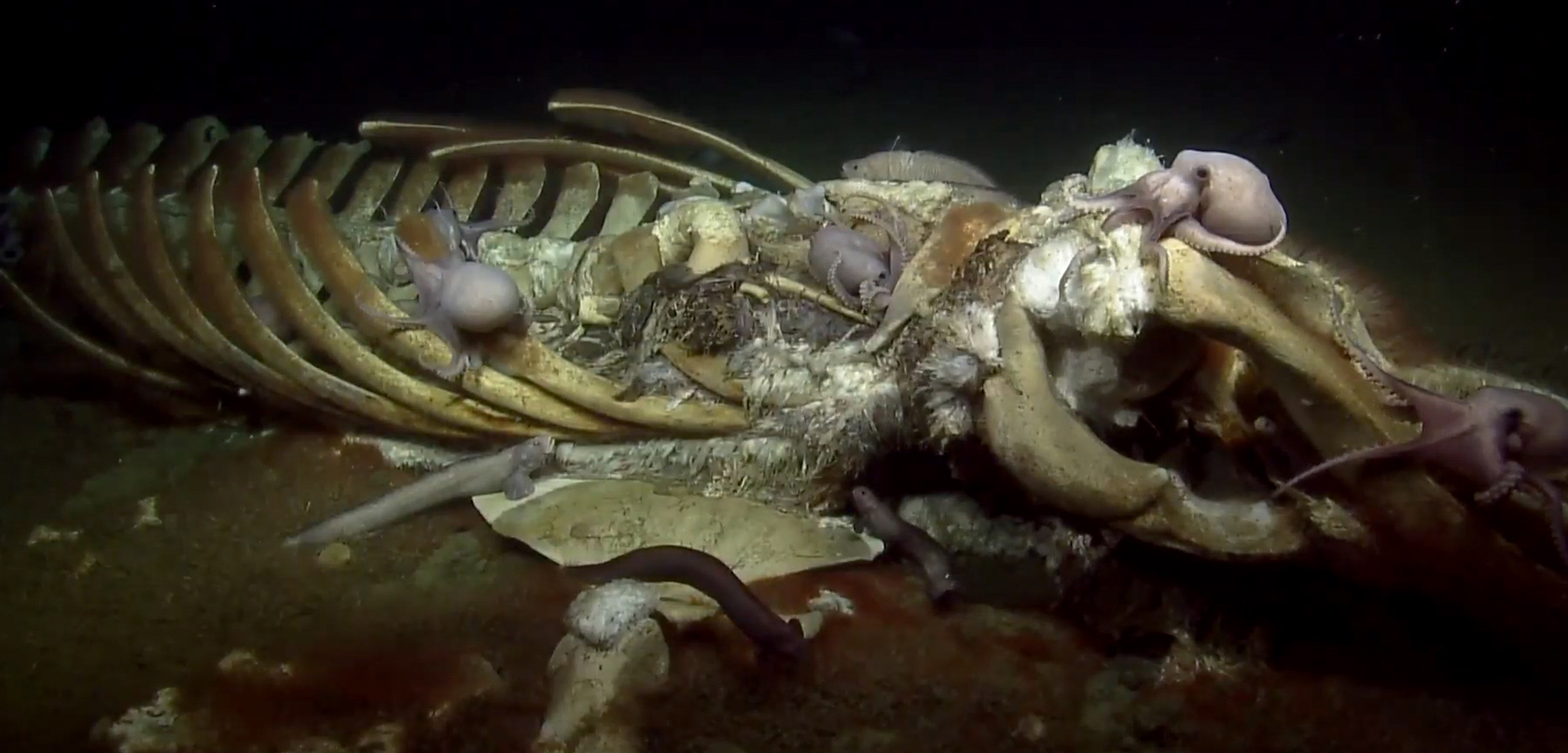More Whale Falls Found off Los Angeles than in the Rest of the World Combined
A mysterious discovery reveals how little we know about the deep ocean.
Article body copy
A pair of scientific surveys recently turned up a few surprises on the seafloor off the coast of Los Angeles, California. First, there were the tens of thousands of naval weapons. And then, researchers found the remains of whales—seven confirmed and almost certainly more than 60 total skeletons in the dark depths, a phenomenon known as “whale fall.”
Eric Terrill and Sophia Merrifield, oceanographers from Scripps Institution of Oceanography at the University of California San Diego who led the surveys in 2021 and 2023, had set out to assess waste scattered across 350 square kilometers of seafloor encompassing the San Pedro Basin and part of the Santa Monica Basin. The area—twice the size of Washington, DC, and centered about 25 kilometers offshore—was used as an industrial dumping ground in the early- to mid-1900s. A large number of the objects the survey found turned out to be barrels containing the banned pesticide DDT and its toxic byproducts.
Before this effort, scientists had found only about 50 whale falls in all the world’s oceans since 1977, when a deep sea naval vessel spotted the first specimen off nearby Santa Catalina Island. When these large marine mammals die and sink, they form biological oases on the resource-poor seafloor. Whale falls provide nourishment and even habitat for a wide range of creatures—from scavenging hagfish and sleeper sharks to microbes, mussels, clams, worms, nematodes, crabs, and members of the jellyfish family.
Greg Rouse, a marine biologist at Scripps Institution of Oceanography who helped with the surveys, says that the remains belong to gray, blue, humpback, fin, sperm, and minke whales. The number of skeletons is “higher than I would have expected, based on our regional calculations,” by a factor of three to five, says Craig Smith, a professor emeritus of oceanography at the University of Hawai‘i at Manoa who led the first-ever expedition to study a whale-fall ecosystem in the late 1980s, but who wasn’t directly involved in the survey. Smith has published estimates of how many whale carcasses would likely be found in various locations, including off North America’s west coast. Those estimates are based in part on the assumption that whale falls last an average of 12 years before disintegrating or being covered by sediment. But even if they stick around for up to 70 years, Smith says, “you still don’t get up to the densities we’re seeing in the San Pedro Basin.”
One potential explanation is simply that “this is the highest-resolution survey in an area of this size ever done,” says Smith. Understanding the typical number of whale falls across oceans would require conducting similar high-resolution surveys elsewhere. A lack of oxygen in the water also likely contributed to the number of intact skeletons. The basins’ deep troughs plunge down 800 meters and are surrounded by sills that discourage mixing with more oxygenated waters. That leaves oxygen-poor zones where the microbial and biological processes that break down whale bones proceed very slowly, Smith says. For example, when Terrill and others used underwater autonomous vehicles to collect photos, videos, and other data from seven of the carcasses in 2023, they found no bone-eating worms—red creatures with featherlike gills that are among the most common denizens of whale falls—coating the skeletons. Another factor in the number of visible whale falls may be that no rivers flow into the ocean nearby, so there’s less sediment input to cover up sunken objects.
Researchers think it’s unlikely that the toxic waste and weapons dumped here played a part in killing the whales, but the area is heavily trafficked by ships, and it’s possible that more whales die here by ship strike than in other places. The United States’s two busiest ports, in Los Angeles and Long Beach, are just northeast of the study site, with shipping lanes extending throughout the region. Meanwhile, thousands of gray whales migrate through each year, and blue whales feed here regularly, says John Calambokidis, a marine biologist at Cascadia Research Collective, a nonprofit based in Washington State.
Scripps Institution of Oceanography researchers plan to eventually return with a remotely operated vehicle to collect more photos and videos of the whale falls, which will help them confirm what species are among the dead, and potentially even reveal signs of ship-strike trauma. Smith and Rouse would also like to retrieve bone samples from the skeletons to determine how the whales died and learn more about their lives.
The abundant whale falls provide a concentrated opportunity to learn more about the food webs these biological bounties support and the lives of the creatures who depend on them. They may also reveal more about the role decomposing whales play in the ocean’s carbon and nutrient cycle. If they last for many decades in other places beyond these basins, “the big oceanographic picture would be different,” says Rouse, because it would mean that these behemoths are transporting and sequestering more carbon on the seafloor than previously thought.

